Cory Huff's Blog: The Abundant Artist Goodreads blog, page 20
June 28, 2018
How to Retarget Potential Collectors After They Leave Your Site
Imagine the journey of a typical visitor to your website. Perhaps they found you through a Google search, a Facebook ad, or a referring link from someone else. They arrive on your site, and immediately they click on a painting of a ship that you have for sale. Then they leave. Even though this person is fascinated by your work and is your ideal customer, this is the end of your interaction with that person- no sale, no further relationship.
Now imagine that you use a marketing tool to create an ad about your series of nautical paintings. After the visitor leaves your site, you have a system set up to place the ad in front of that person in a setting they’re comfortable with and using often (Facebook). Your ads show up regularly until they remember how intrigued they were by your work… and eventually you make the sale. Nice!
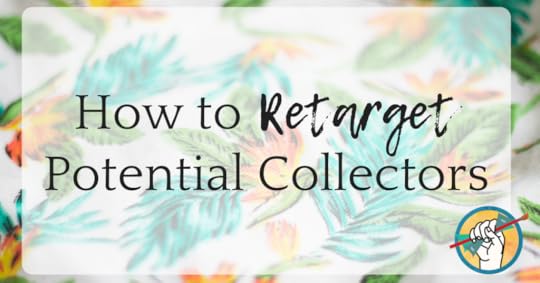
What is Retargeting?
This is the essence of retargeting- which you may have also heard of as “remarketing”. Retargeting is about using the information you have on visitors to your site to create targeted ads based on what seems to interest them. Understanding how to retarget potential collectors can be a powerful key to growing your list, maintaining awareness of your brand and increasing sales. A very specific ad placed on front of people who have already visited your website can result in a much higher chance of making a sale.
Using a Facebook Pixel
You often agree to the use of “cookies” on various sites when browsing the web. These cookies are sometimes called pixels, and they are the trail of breadcrumbs that enables retargeting all over the internet. If you’ve ever shopped for bird baths on Amazon and then suddenly started seeing ads for birding stuff all over the place, you’ve experienced retargeting.
Once a Facebook pixel has been installed into your site’s code, you will be able to segment your audience in Facebook Ads Manager very specifically down to people who have visited only certain pages on your site, and deliver targeted ads to them on Facebook. These ads can be really effective if used correctly.
Tips for successful retargeting
Retarget using products you know those visitors already showed interest in. If they spent time looking at a certain type of painting, that’s the series you’ll want to advertise to them in your targeted ads.
Retargeting needs to be part of a larger marketing strategy, in which you have a plan for driving traffic to your site, a plan for what to do with them once they’re there, and a plan for retargeting. To that end…
You need to know what you’re doing. Retargeting is not a strategy for beginners- working with an experienced marketer can help you learn the ropes and see an increased return on your investment.
Interested in Learning More?
Our self-directed course Facebook Marketing for Artists goes into more depth with Facebook pixels- how to get yours and install it on your site, as well as other strategies for using Facebook to increase your online art sales. Find out if this course is the right fit for you.
The post How to Retarget Potential Collectors After They Leave Your Site appeared first on Online Marketing for Artists.
June 20, 2018
What is a Boosted Post?
Boosted posts are useful tools for your business Facebook page but they should not be confused with using the advertising interface, where there are far more options. They are useful for creating a Facebook post that you want to get in front of more people who already like your page, such as sharing an event, an important blog post, or a poll, but you probably don’t need to boost your posts nearly as often as Facebook will suggest it to you.
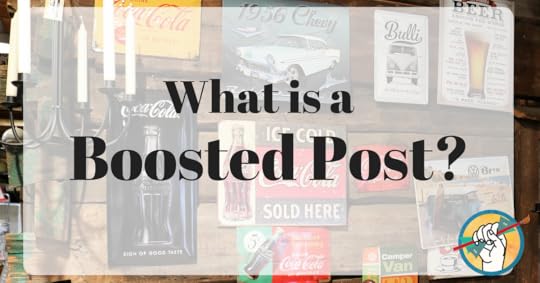
What is a boosted post?
A boosted post is an organic post that you’ve paid to have shown to more people. It functions differently from an ad in that you create the post, then have the option to boost it. You don’t have the same high level of control over the details, and can manage it from your Facebook business page rather than switching over to the more complex Ads Manager.
How to boost a post
To boost a post, once you’ve published an organic post on your page you will see a little blue button on the bottom right corner of the post.

Click this button and a popup will appear where you can fine tune your audience and select your budget and the duration of the boost. You can see in this screenshot a warning that the post may not work; similar to actual Facebook ads, posts with too much text may not be approved. The most successful posts have a certain balance of text to image. You may have to play around with this a bit to get it right, which is why it’s important to have a set budget in place that you can spare until you have it figured out.
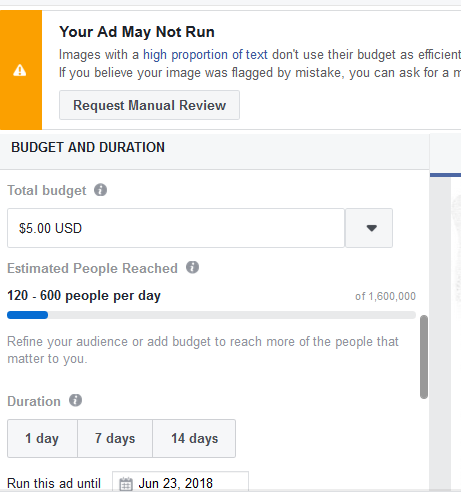
A slider will show you how many people you can expect to reach for your budget, and how much you will spend each day for the duration of the boost.
Best practices
Check the Ad Criteria
As mentioned above, Facebook is picky about the ratio of text to image. Too much text will be rejected, and this includes text in the image itself. Some posts will not boost successfully for this reason. Facebook has a tool for checking the text ratio on your ad.
Check the Insights
Before boosting a post, even if Facebook recommends that you should, hop over to the Insights tab and see how well your post is performing. If it’s doing better than the bulk of your other posts, move on to the next criteria. If it’s performing poorly, boosting it isn’t going to worth your time or money and you would be better off creating a finely-tuned ad or working on better organic content.
Check the Purpose
So your post has the right ratio of text to image, it’s performing really well, and Facebook is suggesting that you boost it. This still doesn’t mean you should. First consider the purpose of the post: is there an advantage to your business? What are you hoping to accomplish by getting this post in front of more eyes? Will it point them to an important blog post with a call to action, send them to a special sale in your shop, or ask them to participate in an important poll? Make sure that you’re spending your money on posts that will bring you a return on your investment. A high number of people reached on its own won’t accomplish more than awareness.
We do a deep dive into paid Facebook ads and boosted posts in our Facebook Marketing for Artists course. Click here to see if this course is right for you.
The post What is a Boosted Post? appeared first on Online Marketing for Artists.
June 13, 2018
Paying for Facebook Ads? Here Are Your Options
If you run a business page on Facebook to sell your art, you’ve likely noticed that Facebook works very hard to keep users on their network, and they work equally hard to convince you to pay them to show your content to your fans- the people who already like your page. Posts with outbound links, especially, will be shown to only a tiny fraction of your audience. The solution to this issue, if you have decided that Facebook is still where it’s at for your business, is paying for Facebook ads. Check out this post for a quick overview of the difference between paid and organic Facebook content.
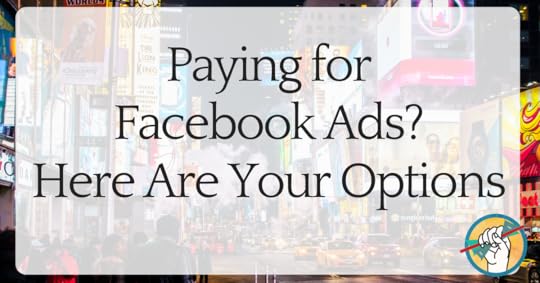
Note: Paid ads are slightly different from boosted posts, which we will cover in more depth in a blog post next week.
What is a Paid Ad?
You get them in your feed all the time. Paid ads show up in your feed with a little gray “Sponsored” under the page name. Paid ads are actual advertisements created for the purpose of being shown to as many people as possible within a certain refined demographic. The most successful paid ads have a very specific and easy-to-follow call to action.
How they work
Facebook Ads Manager is the dashboard you’ll use to create ads. The ads are a combination of an image and text. Facebook is very picky about the images- they can contain only a very small amount of text, and you will have to submit your image for review before your ad is approved. Ads often include a link as well as a Shop Now or Sign Up button- that’s your call to action.
Best for…
Facebook ads are great for advertising a sale or the launch of a new product line (like a new series of art) or an online course. A paid ad is the only place you can post an outbound link on Facebook and hope that more than a tiny sliver of your audience will see it.
You should focus on paid ads if…
You have a marketing budget. When you are starting out, you can expect to burn some cash as you figure out what demographic portion of your ideal audience actually responds to Facebook ads- you can drill down pretty far and get quite specific, so figuring out what works takes some trial and error.
You are ready. Don’t start running Facebook ads just to drive traffic to a website if you have no plan for what to do with those eyeballs once they land on your page. A successful ad will have a specific purpose and a strategic plan to convert clicks into something you want- whether that’s a sale or a sign-up.
You should know how to tell a compelling story about your art, know your ideal collector, and your unique value proposition before you start advertising.
The bottom line about paid FB advertising is that it’s a great way to get an outbound link with a specific call to action in front of a really specific group of Facebook users. Before dipping your toes in the water you’ll need to be sure that you have a plan in place and you’ve done the market research to determine who you’ll be targeting. Be ready to drop some cash to figure out what works.
If you think Facebook marketing is a good fit for your art business, head over to Facebook Marketing for Artists for an in-depth study of running successful Facebook ads.
The post Paying for Facebook Ads? Here Are Your Options appeared first on Online Marketing for Artists.
June 6, 2018
The Difference Between Organic and Paid Facebook Posts
If you’re just dipping your toes into sharing your art on a Facebook business page, no one will blame you for feeling perplexed over some of the terminology being thrown around. Buckle up, because the term “organic” isn’t just for overpriced fruit anymore.
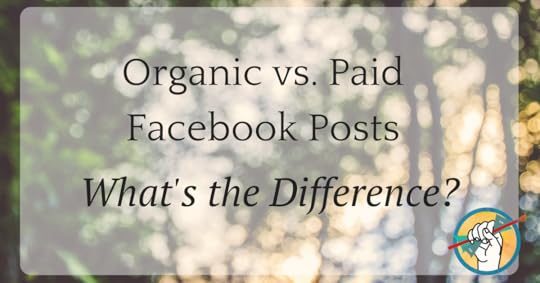
Organic Facebook Posts
What they are
“Organic” is a term that in this case means unpaid. Anything you post on Facebook without paying is an organic post. Work-in-progress photos, random thoughts, sharing posts by other accounts, and links to blog posts are all organic posts as long as you don’t pay to boost them (more on “boosting” later). Organic posts will generally reach far fewer eyes than a paid post, unless it happens to go viral.
What to use them for
Use organic posts for everyday interaction with your followers. Ask questions, share photos of your works in progress, share what you ate for lunch!
When not to use them
If you are ready to announce a new series of work that just went live in your shop, make a super important announcement that you need as many followers as possible to see, or promoting a sale, you may want to consider laying down some cash instead.
Paid Facebook Posts
What they are
There are two types of paid Facebook posts, which we will cover in depth in a future article: paid ads, and boosted posts. Paid ads are advertisements that you create in Facebook Ads Manager with the express intent of showing up in someone’s feed who wouldn’t otherwise probably see your post, to advertise something important to them.
“Boosting” a post, on the other hand, is paying money for Facebook to show what was originally an organic post to more of your own followers that weren’t seeing the original post.
What to use them for
If it’s something you’d pay money to have advertised in a more conventional sense (for example, if 5-10 years ago you might have paid to show it as an advertisement on a high-traffic website), you should pay money to advertise it on Facebook. The most successful ads will be targeted to a specific group of people with a specific action they can take.
When not to use them
Don’t boost posts willy-nilly just because Facebook tells you that you should (and it will). Paid Facebook posts should be strategic and planned in advance
Is this all feeling a little overwhelming? There is help! For the month of June, The Abundant Artist Association is focusing on paid Facebook advertising and sales funnels- there will be a live coaching call and a month-long challenge to help you understand and start creating paid Facebook posts that actually WORK, as well as access to a community of highly-motivated professional artists.
Learn more about joining The Association here.
Need more help with Facebook? Check out Facebook Marketing for Artists.
The post The Difference Between Organic and Paid Facebook Posts appeared first on Online Marketing for Artists.
May 23, 2018
Should I Frame My Artwork Myself?
Should I frame my artwork myself when selling prints and originals online? This is a very common question in the TAA community. This is an important decision to make for the sake of your art business- consistency is essential, and the ability to at the very least point your collectors toward quality framing options if not do it yourself is important for appearing professional and competent.
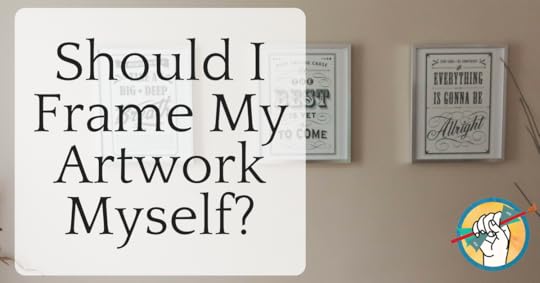
Why to Frame Your Artwork Yourself
You Have Maximum Creative Control- If the thought of your artwork in an ugly or ill-matching frame keeps you up at night, make it a part of your creative process. Some artists choose to pick out the frame first and let the color and style inform the composition of their pieces. Make framing part of your workflow to ensure that wherever your art ends up hanging, it’s going to represent your vision from start to finish.
It’s Easier for Your Collectors- It’s so much easier to buy artwork that arrives ready-to-hang. It eliminates the sometimes intimidating and time-consuming step of finding the right frame. Do this work for your collectors and they will thank you for it!
You Look Like a Professional- Knowledge and helpfulness about framing with give your collectors confidence in you as a professional. You can even offer to install the work yourself if you want to take it a step further.
Why Not to Frame Your Artwork Yourself
It Takes More Work- This doesn’t really need to be a downside, if you get it down to a system. Some artists, like Owen Garratt, choose to buy the same frame in bulk. This is also work you can delegate.
Higher Upfront Cost and Higher Prices– You’ll need to eat the initial cost of the frame, then factor it into the final price of your work at a markup. This should not be an issue once your work is in demand, but for artists just starting out this may feel prohibitive.
Shipping Takes Extra Care- Many artists are justifiably concerned about sending glass through the mail. You’ll need to take extra care to ensure that it arrives safely. One popular solution to this issue is plexiglass.
The Bottom Line, and a Few Tips
Provided it applies to your work, framing is something you should take into consideration from the moment you start planning a new piece. It may feel like a headache at first, but figuring out what will work for you and your art will not only make you look more professional, but it will result in happier collectors which is, of course, great for you.
Many artists choose to offer framing as an upgrade- this is an excellent and professional option that allows for collectors with a broader range of budgets to access your work.
Here are a few tips and workarounds for you as you figure out the best way to approach framing for your art business:
-Get creative if budget is an issue for you- shop thrift stores for cool frames, or buy in bulk at a wholesale price if you know you’ll be able to move them.
-Sell your work matted and ready-to-frame as an in-between option. This option is less expensive for you and your collectors, but significantly more professional than offering nothing at all.
-If you don’t want to frame your artwork yourself, consider compiling resources to give your collectors to help them get it framed and thus care for your work. Include suggestions for where to buy frames, and what kind will look best and most effectively protect your work. You can compile a printout of resources to send in the mail with the artwork, or send it with links as a thank-you email.
Do you have tried-and-true tips to share with the community on framing your work? Please share in the comments!
The post Should I Frame My Artwork Myself? appeared first on Online Marketing for Artists.
May 15, 2018
How to Build a Career When You Have Too Many Interests
Are you happy to give all of your focus and passion to just one or two interests, perhaps building your career around that interest? It often feels like the expected norm, but there are so many creative souls out there that feel stifled by the prospect of settling on just one thing.
If you’re nodding your head, you might be a multipotentialite.
What’s a Multipotentialite?
TAA founder Cory is one. Emilie Wapnick is, too. Her TED talk on being a multipotentialite is a must-watch:
A multipotentialite is someone who has a wide array of passionate interests, and who struggles mightily with feeling forced to choose one to focus on.
Why it Feels Like a Bad Thing
Being a multipotentialite can cause you to feel like there’s something “wrong” with you- while everyone else is settling into focused careers, you balk at the prospect of narrowing your field of interest. You may end up spinning your wheels and not getting much done at all, afraid of missing out on something great if you settle.
Why it Can Be a Great Thing
The great news is that multipotentialites are curious, passionate, and driven people. With a little guidance, you can learn how to thrive and create the life you’ve dreamed about without giving up any of your varied creative pursuits. Check out this podcast episode we did with Emilie on how to build your dream career when you’re a multipotentialite: https://theabundantartist.com/podcast12/
Multipotentialite Must Haves
If you’re going “wow… that sounds like me,” check out the Multipotentialite Must-Haves bundle:
Multi-Passionate Must-Haves is a bundle of 17 hand-picked books, courses, and resources that will help you build a sustainable life and career around your MANY passions. This year, the products in the bundle will address three broad topics: work, creativity and fear. These tend to be areas of challenge for multipotentialites. For 72 hours, you can buy all 17 products for $97 (a 94% discount).
Just a few of the cool things included in this bundle:
The Abundant Artist Association (3 month membership) by Cory Huff- hey, that’s us! ($100 value – EXCLUSIVE)
Figure Out What Fits by Scott Anthony Barlow ($397 value)
Erase the Chaos Toolkit by Melissa Dinwiddie ($20 value)
How to Be Everything Bonus Interviews by Emilie Wapnick–($27 value– EXCLUSIVE)
Premium Momentum Planners by Charlie Gilkey ($12 value)
Rock Your Systems by Michelle Nickolaisen ($47 value)
Ask An Oracle Call by Dyana Valentine ($100 value)
Roots and Wings by Paula Jenkins and Christy Tending ($149 value – EXCLUSIVE)
The NOW Year™ Action Plan by Mike Vardy ($199 value)
Crowdfunding Essentials by Nicole Piar and Jennifer Lee ($97 value)
Renaissance Business by Emilie Wapnick ($49 value)
Unveiling Your Business Uniquity & Making It the Foundation of Your Brand by Michelle Ward ($97 value – EXCLUSIVE)
The total retail price for the bundle comes to $1,594, but until May 17, you can grab all of these products for $97. Get the Bundle.
The post How to Build a Career When You Have Too Many Interests appeared first on Online Marketing for Artists.
May 9, 2018
7 Fine Artists Killin’ it on Patreon
Have you given any thought to converting your existing collector/fan base into patrons on Patreon? While there is not necessarily a single “right” way to run a successful Patreon campaign, many of the highest-paid fine artists on Patreon are doing very similar things.
One approach in particular that stands out? Many successful fine artists put on the mantle of educator in order to find real success on Patreon. Many of these artists build up a following on YouTube by posting regular tutorial/process videos. They then send those fans over to Patreon, where they can get access to additional videos, downloads, and even personalized critiques (at higher pledge levels, of course).
Take a look at some of these fine artists that are killing it on Patreon, and be inspired!
Lisa Clough– https://www.patreon.com/Lachri Lisa Clough’s Patreon currently has 1,638 patrons and she is bringing in an astonishing $7,779 per month. She is an artist working in a wide variety of mediums, and sharing tutorial videos (she started on YouTube), live streams, reference photos from her videos. She has really built up a devoted community, and she cultivates and supports this with group art challenges.
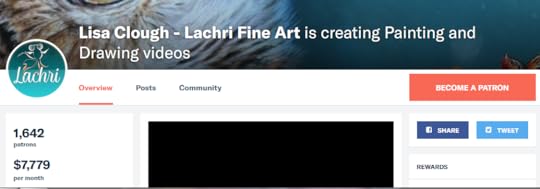
Karen Margulis– https://www.patreon.com/karenmargulis Karen Margulis currently has 610 patrons. She is a pastel artist and educator. She shares process videos, tutorials, and paint along demos with reference photos. She really goes the extra mile as an instructor, providing exercises for painting practice, PDF handouts, and step-by-step videos. She also offers personal art critiques for higher tier patrons.

Maria Raczynka- https://www.patreon.com/mariamorjane Maria Raczynka is a watercolor artist with 492 patrons, and she charges a flat $6 per subscription (although by popular demand she created a higher level tier for people who really appreciated her work and just wanted to give her more money.) She posts edited process and tutorial videos on YouTube, and patrons gain access to the original real-time videos as well as sketches, online classes, and other resources such as watercolor tips, color swatches, and pencil sketches.
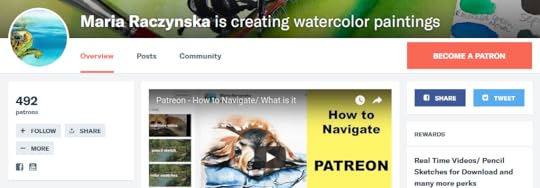
Jason Morgan- https://www.patreon.com/wildlifeart, Jason Morgan is a wildlife artist with 832 patrons. He keeps things relatively simply, but it’s working very well for him. He offers tutorial videos with accompanying royalty-free reference photos and line art. He also offers personal art critiques and additional videos for higher tiers. He has a companion website created by a fan that compiles all of his tutorial videos in one easy-to-find place and also allows patrons to vote on monthly challenges. Keep this in mind if you decide to create your own Patreon (or if you already have one)- fans love the ability to vote on something, whether it’s influencing an upcoming challenge or lesson that they can participate in, or just allowing them a say in what art you create next. This is a really cool way to get your super fans closely involved, create a stronger emotional connection and give them a sense of ownership.

Peter Mohrbacher- https://www.patreon.com/angelarium Peter Mohrbacher is doing something a little different for his 1057 patrons. Rather than tutorials, he has created a fascinating and complex lore around his fantasy paintings (the Angelarium). Rewards include access to limited edition prints and opportunities to obtain sold out prints, high-res image downloads, layered PSD files, and timelapse videos. Fans also get access to a Discord server where they can see behind the scenes photos and chat with the artist. This is a useful model to follow if you’d like to start a Patreon but don’t want to go the route of the educator.

Angela Anderson- https://www.patreon.com/Angelafineart Angela Anderson is an acrylic painter with 1,244 patrons. She is also a YouTuber- she does weekly live painting tutorials as well as pre-recorded videos. She offers supplemental materials like traceable downloads and reference photos as well as behind-the-scenes photos of upcoming projects, and personal critiques.

Wylie Beckert- https://www.patreon.com/wyliebeckert Like Peter Mohrbacher, Wylie Beckert has managed to cultivate a large Patreon following for her art without the use of tutorials. She currently has 735 supporters for her Patreon where she is creating highly-detailed illustrated playing cards with associated lore. For her backers she shares process videos, digital downloads, discounts, and access to limited-edition prints.

If you’re still in the early stages of considering whether a patron/subscriber model is right for your business, you may want to read our post on taking payments outside of Patreon as you weigh your options.
Did we miss any high-earning fine artists on Patreon? Feel free to share them with us below so we can all learn from their example.
The post 7 Fine Artists Killin’ it on Patreon appeared first on Online Marketing for Artists.
May 8, 2018
The Ultimate Guide to Choosing An Artist Website Builder
In February of 2018, we surveyed over 1,000 artists to ask them what their favorite website builders are. This blog post breaks down that survey and shows the most popular website builders among professional fine artists. We also break down the relative satisfaction with each provider.
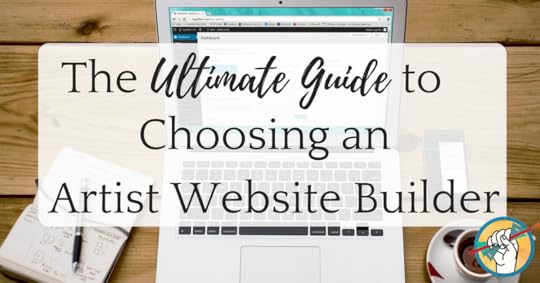
Preliminary information about the survey
Nearly 20% of the artists surveyed didn’t have a website at all. That’s surprising in 2018 and reflects a reticence by artists to adapt to modern marketing. This mirrors data from other well known surveys that show that many art galleries don’t have a plan for digital marketing.
Of those who do have a website, 70% were built by website builders. The remaining 30% were custom built either by the artists themselves or by a web developer that they hired. Artists shared that their custom websites median price was in the $2000 – $3000 range, with outliers ranging into the $15,000 range.
Most popular artist website builders
Below we break down each website provider, in order of popularity. We also asked each respondent to give us feedback on a variety of questions that indicate satisfaction with their website builder.
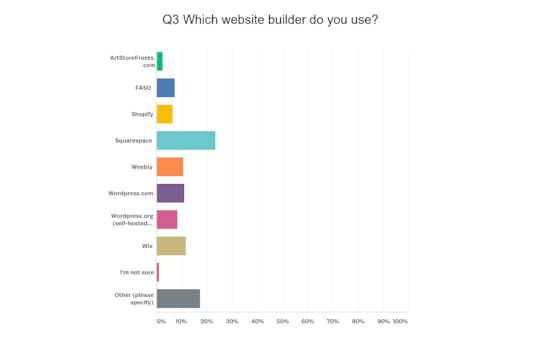
Squarespace
At 23% of users, Squarespace was easily the most popular website builder. It was also among the  builders with the highest satisfaction rates, at 4.6 out of 5. Squarespace offers a free trial and extensive documentation. Squarespace makes building a website very easy. The Abundant Artist offers a course that will help you plan your website and gather your branding and marketing materials in preparation for building. Check out Artist Websites That Sell.
builders with the highest satisfaction rates, at 4.6 out of 5. Squarespace offers a free trial and extensive documentation. Squarespace makes building a website very easy. The Abundant Artist offers a course that will help you plan your website and gather your branding and marketing materials in preparation for building. Check out Artist Websites That Sell.
Quotes from users about Squarespace:
It’s easy to update, has a clean/uncluttered design and easily customizable so it doesn’t look so generic, but I can add my branding to it. SEO is simple too.
Squarespace has many resources if one is intuitive enough to understand the logic from their references. If challenged, their support team is very helpful with guidance, screenshots, and further resources to help one succeed with their goal to build a website.
I had used both WordPress (designed by someone else but maintained by me) and Wix. I read reviews, chose Squarespace and couldn’t be happier. Easy to use for a non-techy, intuitive for the most part and when I really couldn’t figure it out great support thru chat. They do screenshot videos of your site to show you how to do the things you are having trouble with. Love it!!
Some design elements are limited, setting up can be technically challenging (ie. Connecting site with GoDaddy or integrating with Google Suite), does not yet integrate with POD sites like Zazzle (but they’re working on it).
It can be a little glitchy sometimes. There is no stored library of images so you have to find and upload the same one multiple times if you want to use the same image on more than one page.
There is not yet an option to have the price displayed with the country’s currency next to it. USD or NZD, for example.
Commerce end is a bit clunky and I had to create a work around.
Wix
At 11.68% of our artists surveyed, Wix is popular for its free trial and how easy it is to use. Its satisfaction rate of 4.27 out of 5 is just slightly less than Squarespace, and this is generally because it has fewer customization options than others. Wix also had a problem with being de-indexed by Google in 2015, and many professional developers have concerns with their underlying code. That said, it remains quite popular.
Quotes from users about Wix:
Really easy and intuitive. Tried Weebly for another site and it is difficult.
– easy drag and drop functionality – great for graphic designers wanting to fine tune the look. – user friendly eCommerce with a phone app that notifies you when someone buys a product or sends a message. – I also like the mail ‘shout outs’ and have swapped from using MailChimp to fix for this too.
With no experience I was able to easily build and maintain an attractive site. There was no pressure to do it quickly due to their open trial period which took the stress away and gave me the freedom to figure it out. I also love how easy to attach images to a link which leads to the site I sell from.
Not enough capabilities for custom tweaks for mobile view.
If I wanted to change templates I’d have to start all over.
I can’t change the template. Once you pick a template you’re stuck with it. The work around is you can basically redesign it. The drawback is this takes time.
Not easy to integrate with a POD service – like Printful. Possible but NOT easy. Considering switching.
WordPress.com
At 11.07%, the hosted WordPress solution (as opposed to the self-hosted and more customizable WordPress software) is very popular. Its customer satisfaction rating is just 3.85 out of 5. More than 60% of responses said that WordPress.com is easy to use and inexpensive. But when we asked what people dislike, the most common responses were that there is a steep learning curve. This leads us to believe that many WordPress.com users are more tech savvy than the average user.
Quotes from users about WordPress.com:
There are endless templates and plugins so that I can modify and enhance my site as my business grows. Initially, I did all the design and setup. 2 years ago I hired a web designer and a web developer to redo my site. I stayed with WP platform. I can go in and do easy tweaks but I now pay them to design new pages for other offerings like courses and creativity retreats but I can add blog posts, images and ultimately manage my shop (it is WooCommerce shop and is under construction).
Easy to use once you learn the basics. Many online tips from the team and from users. I can use a template instead of making up the whole website from scratch. It is free to use if you are just starting as an artist, but when you start to be serious about your business you can go for the paid version without ads. You can have a portfolio and a blog there and both work well. WordPress is a blogging community so you can follow and interact with many people who do art as well.
Would like to see better integrated online store feature, and would also like better integration with Google Analytics, not just the built in stats.
I do not dislike anything so far. But WordPress generally is for people who like to play with details and learn the settings. I learned on my personal blog all the tricks, so it was easier to stay on the same builder for my art website as well.
Well, you have to dedicate many hours to learn how to use it. Each template comes with different things to learn. When there are problems, you have to spend a lot of time finding answers in forums or YouTube videos among other.
Learning to build on WP the first time is a full time job. Hire someone if you can afford it or you will be spending all your time in front of a computer screen!
Weebly
At 10.66% of users, Weebly is popular, but its customer satisfaction rating at 3.7 out of 5 is the second lowest in our survey. They were recently purchased by Square, so major changes may be in order.
Quotes from users about Weebly:
It’s incredibly easy to use, and has beautiful, customizable templates. It also has an app where I can track visitors, edit my site on the go, and most importantly see when someone writes to me through the contact form and respond accordingly.
It’s easy to use overall. Physical, digital, and services options for products make it easy for me to sell paintings, downloadable items such as e-books, and workshops and classes. And it’s easy to offer a coupon and to have multiple shipping options based on price.
Weebly is completely free if you need a simple website. It’s so simple to use, and has a blog which links to social media. I love it. I initially had a Wix site offering the same level of service but you had to pay for even the most basic level. The customer service is excellent too.
Most everything other than above is clunky and often buggy, plus too many functions are costly add-ons without important functions – for example, you can pay for “abandoned carts” but cannot get the data on what people are leaving in their carts – pretty important in my opinion. Data downloads are not good because you cannot select what you’d like to download. No image library for prior uploads. Images have to be to particular specs for particular uses. Crazy.
The website’s abilities are priced into different packages. It makes you feel like you’re being nickel and dimed for services.
That it does not have a library storage of photos I upload. If move or delete an image from 1 page, I have to upload it again.
WordPress.org
At 8.4%, self-hosted sites using the WordPress software have the flexibility that those who like to control every aspect of their sites crave. The customer satisfaction score of 3.8 out of 5 shows that WordPress is perhaps not the best fit for every artist. WordPress, by some estimations, makes up more than 20% of all sites. The ability to control every aspect of your site, down to the code, is great, but it creates traps that many artists find themselves spending more than 40 hours to learn how to overcome. For those who like the DIY model, we’ve done an extensive guide to the Divi theme, probably the best drag and drop theme builder for WP.
Quotes from users about WordPress.org:
I’m used to WordPress now so the thought of switching and going through a learning curve seems daunting! Also, WordPress is free and that’s HUGE since I haven’t sold much yet. It gives me the time I need to get up and running. In the future, when I can afford a webmaster, I won’t care and would be willing to switch. However, I know that getting a website back that’s fancy and complicated can be a huge bomb for a business. We’ve had that experience too. So I tend to choose webmasters who use WordPress or something that’s on that level.
Enormous flexibility and support, and the independence of using one’s own choice of hosting.
WordPress is easiest to get answers when you have a problem – just Google the problem and you get 50 solves. And for any template you use, you can get a video on YouTube that can take you step by step on how to set it up.
Can be customized to do anything unlike the other site builders I have used previously. I also am in complete control of everything to do with the site and not at the whim of a company trying to get more money out of me for extra functionality.
I use a theme (Headway) that is far too complicated for my needs. When I first started using it in 2010, it was much simpler. It’s grown so complex that I dread making changes, even though I’m a reasonably intelligent and tech-savvy person. I’m grandfathered in with Headway so I don’t pay a subscription fee – a recurring fee for the theme would have been a deal-killer for me – but I’m now afraid to get into the backend because I’ll have to learn everything again from scratch, when I’ve already put years of sweat into it. And I’m overwhelmed by the thought of switching themes – what if I have to switch back and lose all my years of customization? So instead my website languishes, doing nothing. Other things I’m not fond of include managing security and backups. It can be a little heavy if too many plugins are used. It’s tough to have a lean, fast-loading site if you don’t know what you’re doing.
Fine Art Studios Online (FASO)
At just 7.38% of our users, FASO makes up a very small proportion of our survey respondents, but FASO has been around for a long time. They have a customer satisfaction of 4.62 out of 5. A big part of that is their origin as a company specifically for artists. Their templates are designed for artists and they have artists staffing their support lines. The downside is their templates can be inflexible and don’t connect well with third party services.
Quotes from users about FASO:
It was extremely easy to set up and get going. Since it was my first web site, that was a huge plus. I had been told that the back end was solid, and that was important to me. They have excellent customer service, and that has been greatly appreciated in the past when I had a question or problems.
It was easy to set up and it is easy to change things. They have a lot of templates to choose from. I have never had any problems with it. They also promote artists who use their products. They are continually making it better.
NOTE FROM CORY: there were more than two dozen responses saying this: most FASO customers have zero problems. We removed these and condensed down for ease of reading, but must emphasize the love FASO customers have for their sites.
Limitations in some templates; too much wasted white space (would love my work to be displayed much larger); integration of pages to sell prints and/or products with my work on it in pages with the original artwork (lower priced or alternative options for folks who aren’t yet ready to invest in fine art); room setting view where customers can see the size / shape of a painting / print in an actual room like over a couch or bed, in a kitchen, etc; greater options in template layout (social buttons and email NL signup at top of page, etc).
Shopify
At 6.56%, Shopify makes up a surprisingly small number of sites for artists. Their customer experience score is 4.27 out of 5. This is despite the fact that Shopify offers arguably the most powerful eCommerce experience on the web. They also integrate with nearly every third party marketing tool available. See our review of Shopify.
Quotes from users about Shopify:
Shopify is a great eCommerce platform and integrates really well with my POD companies. I have greatly appreciated the analytics it offers even in the basic package, and the support has been prompt and helpful when I need it. The website builder itself is simple to use (I think even a novice could use it, but I went in with some experience). What is nice for me is that there is ability to open up the code for the template to make changes if I don’t like something about the template. For instance, in the template I selected, my product images did not indicate if more options (sizes, colors, framing, etc) were available, so I had to add a couple lines of code to make that show up. I just copy/pasted it from the help forums!
Shopify looks MODERN and clean. I like that the template I use has options for blog posts, featured posts, featured collection, large photos… I also like that they keep up with me and send me helping emails (about how to market, sell etc). Price is not the cheapest, but after having my websites running on cheaper ones, I feel it’s worth it. eCommerce possibility is very important. I chose this platform as I looked at pages I liked and noticed they’re made with Shopify. It is also VERY important that the page looks good at iPad and on phone.
The site is easy to use. There was still a bit of a learning curve with understanding how to add customization to the template, but it was much easier than WordPress. I also like the look of the templates.
Clunky blogging platform; mediocre shipping management; proprietary coding language and process (why not just let us use CSS and html?)
The blog feature sucks and setting shipping fees is difficult, especially for international shipping.
Some advanced modifications requires knowledge of coding (Shopify uses Liquid) and would be scary for a layperson, so that means you’d need to hire an expert. That said, the templates give you a lot of options, and so far I haven’t needed to call in an expert. They also have a lot of forums and tutorials to help with set-up.
ArtStoreFronts.com
At 2.46%, ArtStoreFronts.com is a newcomer to the website building space. They originally positioned themselves as a way for artists to sell prints on demand, but have pivoted to being a full service eCommerce platform for artists. Their customer satisfaction score is the lowest in the survey at 3.31 out of 5, although this is admittedly skewed by our small sample size. Only a handful of respondents use ASF.
Quotes from users about ArtStoreFronts.com:
Excellent resources in marketing, focus on commerce rather than a brochure site.
It is a store. You are connected with a print partner.
Integration with white label services for printing and framing; E-commerce and capabilities built in or easier to flow into than building from scratch; unlimited technical support; room viewer; excellent series of communications; value.
They over stress coupons discounts and deadlines in their suggestions of how the artist should market themselves thus making the art look cheap.
Limited options for customization, no help with coding, no email hosting, time consuming to set up because of SEO, they take 10% of every print sale, 5% of originals or other products
Expensive. Learning curve/complexity.
Other Builders – includes a wide variety of more than 20 website building tools, including Adobe tools, Dreamweaver, and GoDaddy’s Sitebuilder program. There were not enough of these participants to give meaningful feedback, but they are also alternatives.
What did people want most from their website providers?
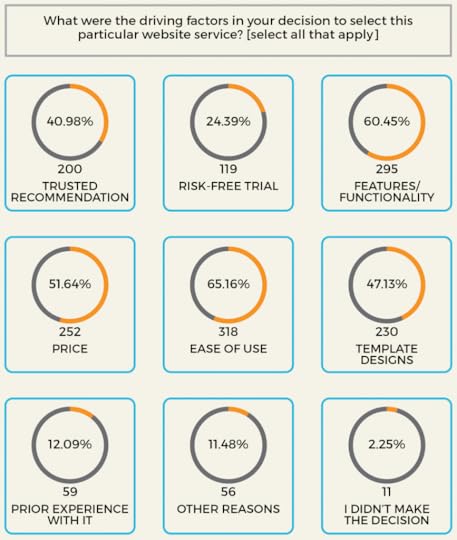
Download our survey data. If you’re the kind of person who wants to examine our data yourself, please feel free to download the data at this Dropbox link.
Artist Websites That Sell
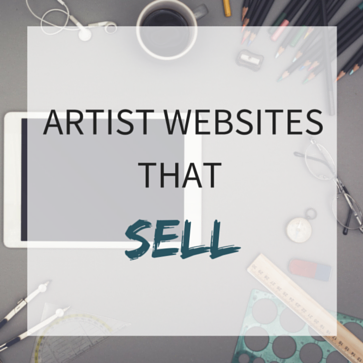 Need a quick prep on what to put on your website, how to decide on your branding, and what to do with your website? Check out Artist Websites That Sell, our course built with award-winning designer Natalie McGuire.
Need a quick prep on what to put on your website, how to decide on your branding, and what to do with your website? Check out Artist Websites That Sell, our course built with award-winning designer Natalie McGuire.
The post The Ultimate Guide to Choosing An Artist Website Builder appeared first on Online Marketing for Artists.
May 2, 2018
Best Papers for Making Art Prints at Home
Are you looking into creating art prints at home? In addition to a quality printer and archival-quality inks, you’ll need to ensure that the paper you print your art on will not only do your work justice, but will last for a long time. We looked at what other artists were saying to narrow it down to 4 of the top most popular papers for making art prints at home.
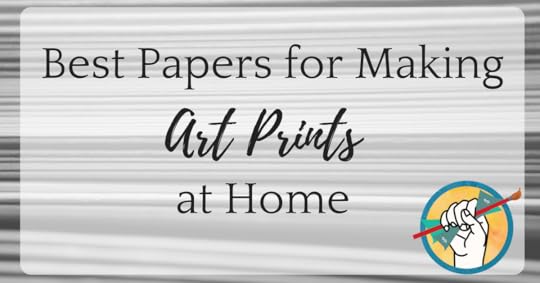
As with all the papers on this list, Moab Entrada Rag Natural 300 is a 100% cotton archival acid- and lignin- free paper with an expanded color gamut, natural contrast, and high ink load. You can use this paper with either dye or pigment inks. A textured variation is also available, and you can choose between bright or natural options to best match the color of the paper to your artwork.
Hahnemuhle Photo Rag is available in 3 different weights, as well as a version with torn deckle edges if you’re feeling extra fancy. This paper was formulated specifically for fine art applications, so you can feel sure that it’s going to complement and preserve the appearance of your art prints. It is compatible with both pigment and inkjet dye systems.
*Epson Ultra Premium Presentation Paper
A note about this paper- it is not specified to be archival or acid-free. This is not going to be the best choice for fine art prints that you hope to last for any real length of time. However, this paper prints images clearly and brightly with a high level of detail, and is a favorite amongst artists for printing their art on other materials not expected to last long, such as flyers
*Hahnemuhle Museum Etching Paper
Hahnemuhle Museum Etching paper is a 100% cotton, heavyweight paper textured like a traditional etching board. According to the description, this paper is ideal for images with soft tints or fine gray nuances.
Did we leave out a paper that you’ve had success with? We’d love to hear from you in the comments.
For more on printing at home, check out our list of the top scanners, the best printers, and more about creating art prints in general.
*affiliate link
The post Best Papers for Making Art Prints at Home appeared first on Online Marketing for Artists.
April 25, 2018
Sell More Art Through Emotional Connection
Art is intrinsically emotional. When you’re creating art that is true to who you are instead of just making the art you think you’re supposed to be making, people can tell the difference. (Check out a great podcast on this topic here.) Pursuing an emotional connection with your collectors throughout the process is an almost surefire way to sell more art over time.
There are six steps you can start following right now to aid in the process of forging an emotional connection with your collectors.

Sign it
All of your originals should be signed for easy verification of authenticity. To this end, make sure that your signature is legible and remains consistent across your entire body of work. This will make it easy for collectors (and perhaps curators) to tell if a piece is yours.
Title it
Giving your work a descriptive or intriguing title will help collectors discuss your work more easily. It will also help collectors and curators identify individual pieces. A good title also allows the viewer a glimpse at understanding the piece. Feeling a sense of understanding does wonders for helping viewers to connect emotionally to your work.
Date it
Put the date for your piece next to your signature. By adding a date, you ensure that people can understand at what point in your career the piece was made, and therefore how it relates to the rest of your body of work. This relates back to the previous point- a glimpse of illumination here and there helps create a sense of emotional attachment to your work. (Also, curators will love you for it.)
Number it
Number your work, especially if you are making limited edition prints. This is also helpful if you are creating a series of works that are relatively similar. Provide each piece with a number or a very specific title to help collectors recognize and differentiate.
Document it
Most artists find it fairly easy to photograph their completed work, but many struggle to document the process of the work as they are creating it. Here’s what you can do: step back from your work every so often, and take a picture so you can see the progress. Not only will this help you to remember the techniques and processes you’ve discovered as you’ve worked, but fans of your work will love to see the in-between shots.
A note about sharing on social media
Social media is social. A lot of artists make the mistake of posting photos of their work to social media, without explaining and giving context. It is very important to spend time nurturing and building relationships with the people seeing your work on social media. It’s an easy rule of thumb: if you’re going to use social media, be social on it.
Explain and give context.
Along with sharing your work in progress, take the time to talk in depth about your work. Your website and mailing list are the ideal places for this, because blogging allows for longer-form communication than social media. Jolie Guillebeau is a great example of #6 in action. She created daily paintings, and sent daily emails to her list with in-depth explanations of her emotional connection to the pieces. Her work almost always sold out.
If you are feeling unsure about whether your art has a story, take a step back for a moment. It is possible that you are not putting enough of yourself into your work. Do you feel an emotional attachment to your work, or are you just creating the work you think you’re supposed to be making? If it’s the latter, it’s time to dig deeper and work harder to impart yourself into your art.
It is also entirely possible that your work is great and has a great story, and you simply need to figure out how to get that story out. A very effective way to discover the story of your art is to document your process. As you are creating your art, take the time to journal. Write down the thoughts and feelings you’re having when you’re making your art. If you journal throughout the creation of your art, you will discover common themes and motifs that run through your art, and which you’ll be able to communicate when it’s time to title and talk about your art.
For more examples and a deep-dive on forging an emotional connection to sell your art, check out the webinar replay How to Raise Your Art Prices. (This replay references some offerings that are no longer available near the end, but overall it’s just full of really good information that is still very relevant.)
The post Sell More Art Through Emotional Connection appeared first on Online Marketing for Artists.
The Abundant Artist Goodreads blog
- Cory Huff's profile
- 31 followers



